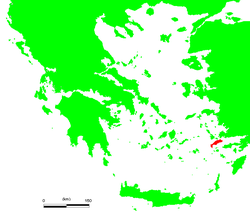Massacre of Kos
About a hundred Italian officers were shot on the commands of General Friedrich-Wilhelm Müller, after being considered traitors for resisting the German invasion of the island (known as the Battle of Kos, part of the Dodecanese campaign).
Eventually, of the 148 officers, seven switched sides joining the Germans, 28 managed to escape to Turkey, 10 were hospitalized and later transferred to camps in Germany, whereas the remaining 103 were shot by Müller's men between the evening of October 4 and 7 near the Tigaki salt lake (Alyki).
[3] After the end of the war General Müller was captured in East Prussia by the Red Army and extradited to Greece, where he was sentenced to death by a military court for retaliatory atrocities against civilians in Crete (but not for the events on Kos).
[4] In 1994, during the trial of former SS Erich Priebke, documents related to the Kos massacre were uncovered among many other files in an archive found in a wooden cabinet facing a wall (the armoire of shame) in the chancellery of the military attorney's office in Rome.
[5][6] In the context of the Cold War era, the military attorney general was under strong political pressure to cover up the material by ministers G. Martino and P. Taviani who feared that Germany, Italy's NATO ally, would be offended.


